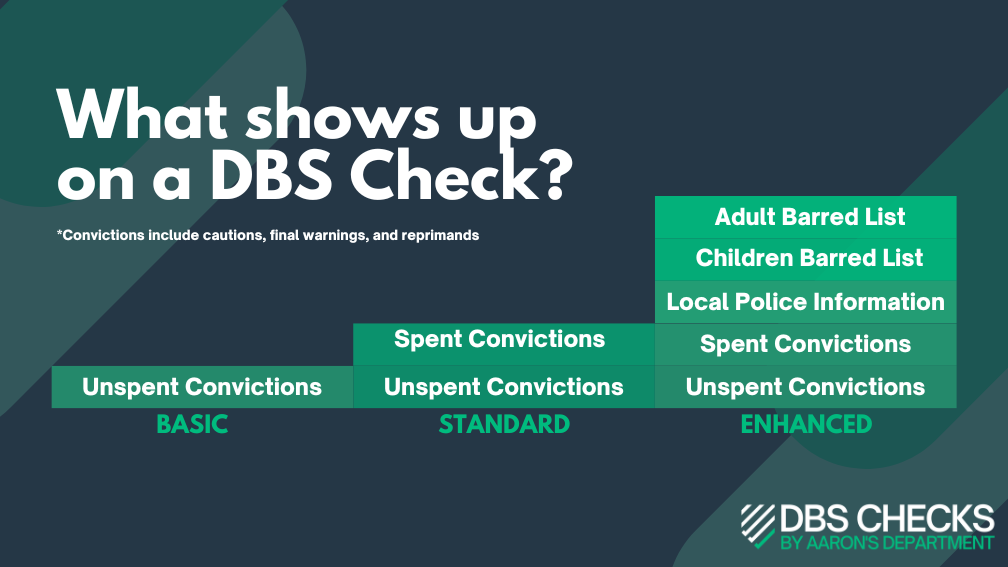Whether you’re being asked to apply for a DBS check or you need some for your staff, this quick guide will cover what information the certificate will show, and the differences between the different levels of DBS check.
Table of Contents
What does a DBS certificate show?
The information on a DBS certificate includes:
Personal Details
– Full name
– Other names & aliases
– Date of Birth
– Place of Birth
– Gender
– Position Applied For
– Name of organisation requesting the DBS check (the employer)
DBS Details
– DBS Certificate Number: 12-digit reference number, unique to your certificate.
– The organisation that facilitated the DBS application (for example, Aaron’s Department).
– The countersignatory working for that organisation who signed off the application.
Disclosure Details
Now for the most important part of the DBS certificate!
Does the applicant have any convictions, cautions, warnings, or reprimands? Depending on the level of DBS check, and whether the offences are Spent, Unspent, or Filtered, will depend on what is shown on the certificate.
Basic DBS applications will only show unspent convictions, cautions, and reprimands, whilst Standard or Enhanced check will show both spent and unspent. You can use this gov.uk tool to check whether your offences are spent. Filtered offences won’t be disclosed on any level of DBS check.
We have also written another blog on the difference between spent and unspent convictions if you’re not sure.
For Enhanced checks where a Barred List check has also been requested, the results will be displayed on the certificate.
Additional Police Information
For an Enhanced DBS check, additional police information may also be disclosed, although this occurs very infrequently.
This represents any additional information the police hold, that they think is relevant to be disclosed for the applicant’s job role. Not all of the UK’s 45 police forces are consulted here, only the ones holding jurisdiction over the applicant’s 5-year address history.
For more information on how this section works, and how information is assessed for relevance, visit our guide to local police information, linked below:
FAQ: Local Police Information
What does a DBS certificate show? The Differences Between Different Levels of Check
There are three different types of DBS check: Basic, Standard, and Enhanced:
What does a Basic DBS Check show?
Basic DBS checks disclose unspent convictions and cautions, warnings, and reprimands. You can use this gov.uk tool to check whether your offence is spent (if so, it won’t show up on Basic disclosures)
What does a Standard DBS Check show?
Standard DBS checks disclose all convictions, cautions, warnings, and reprimands, whether they are unspent or not.
What does an Enhanced DBS Check show?
Enhanced DBS checks disclose the same information as Standard checks, as well as any additional information held by local police forces. When requested, Enhanced checks can also involve checks against the Adults’ and Children’s Barred Lists, disclosing whether the applicant is barred from working with those groups.
If you aren’t familiar with the terms Spent & Unspent, follow the link below for our guide:
Spent and Unspent: What is the difference?
It’s possible for very minor offences, or offences committed while under-18, to be ‘filtered’. This means that they will never be disclosed on any level of DBS certificate. Click the link below to read up on the filtering of convictions:
Guide to the Filtering of convictions


Are fixed penalty notices shown on DBS certificates?
Civil offences, also known as fixed penalty offences, are not disclosed on DBS certificates. Essentially, these are offences that result in a fine, and no further charges or criminal record once the fine is paid.
Do DBS certificates show information on other people?
By default, DBS checks will never disclose information on other people. However, details on other people can show up in the Local Police Information section of the DBS certificate.
For example, if a person applied for an Enhanced DBS check for a teaching role, but their husband was on the Children’s Barred list, it’s highly likely this would be disclosed as additional police information. The police’s decision-making process is shown in the flow-chart below, taken from an official source:


Summary & Examples: What does a DBS certificate show?
What shows up on your DBS certificate depends on your criminal record, and the type of check being requested. Here are a few examples to illustrate:
– If you had a spent conviction and applied for a Basic DBS check, this wouldn’t be disclosed on the certificate.
– If you had a spent conviction and applied for a Standard or Enhanced DBS check, this would be disclosed on the certificate, but employers are not permitted to take it into account when making recruitment decisions.
– If you had no criminal record and applied for an Enhanced DBS check to work in a school, but your spouse was on the Children’s Barred List, this fact would likely be disclosed on your DBS certificate.
Further Reading
We hope you have found our article, “What does a DBS certificate show?” useful. To find out more about the DBS process, visit the links below:
The Difference Between CRB and DBS
The Most Common DBS Check Mistakes And How To Avoid Them
Understanding The Definition Of Vulnerable Adults
